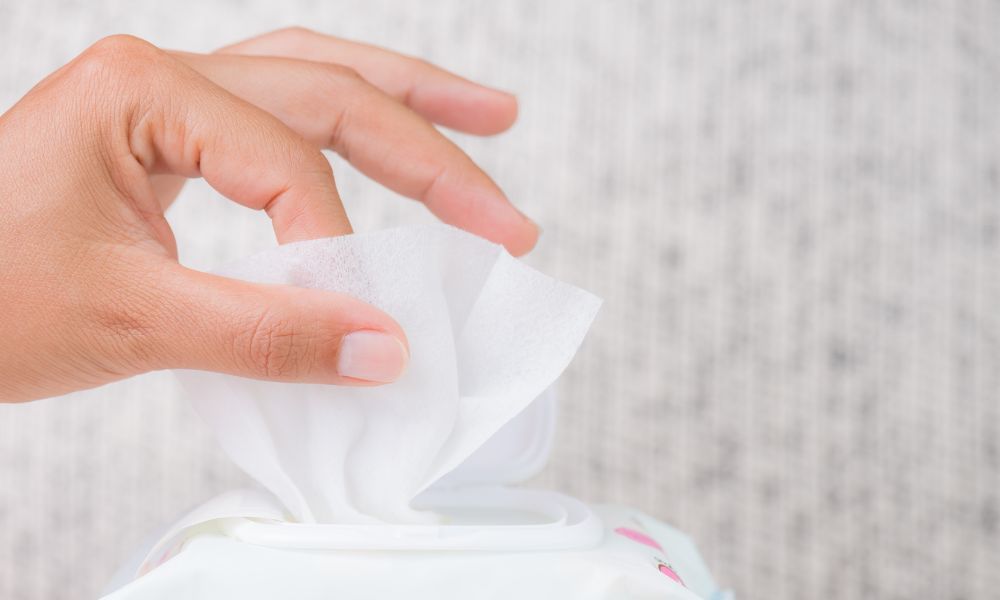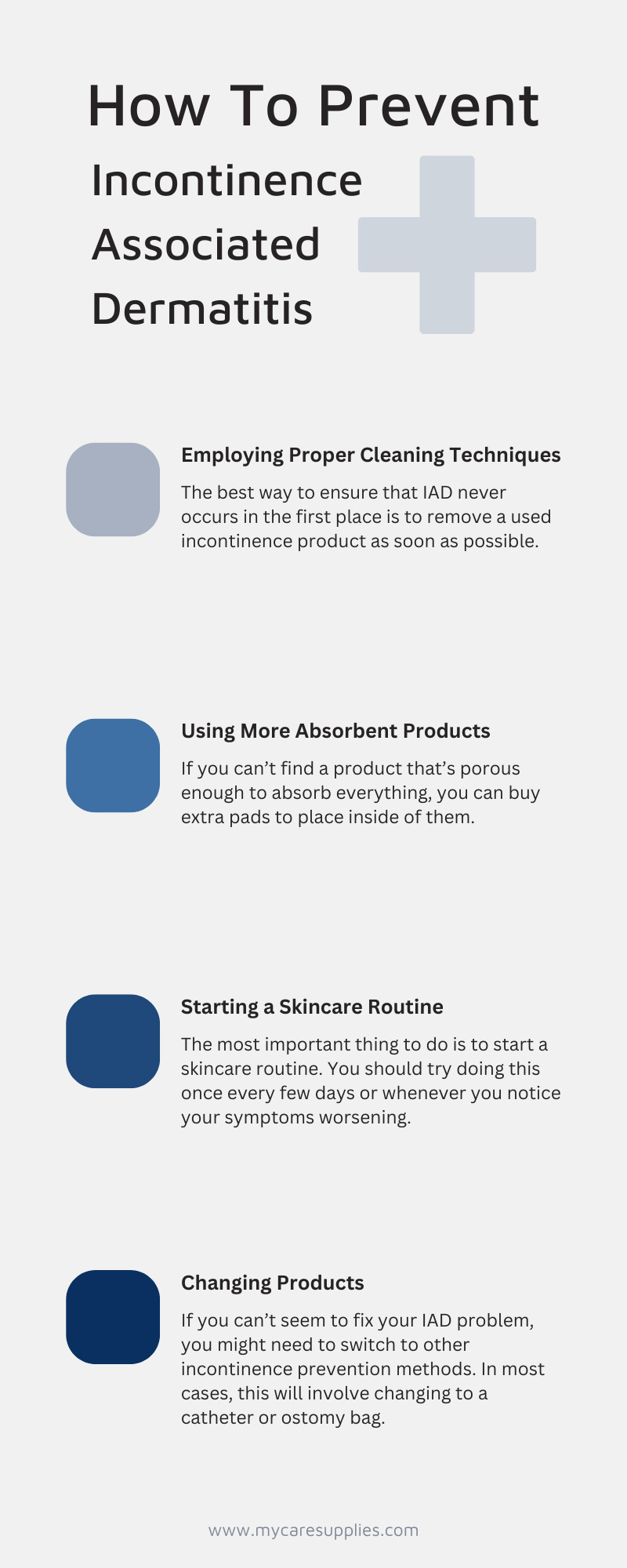How To Prevent Incontinence-Associated Dermatitis
Posted by Jeanne Lowry on Sep 21st 2022

Depending on your age and preexisting medical conditions, using a product such as incontinence briefs can be a lifesaver. They do a great job of preventing any issues you might experience due to incontinence. However, their usage can lead to other potential problems.
One common problem from these products is incontinence-associated dermatitis (IAD). If you don’t take proper care of the area, this skin irritation will most likely become a problem for you. In this article, we’ll go into more detail on what IAD is as well as how to prevent it.
What Is IAD?
Let’s start by learning more about what IAD is. It’s a type of dermatitis that forms when the bacteria from urine or stool breaks through the initial protective layer of your skin. This damaged area can experience infections, leading to a host of potential symptoms. Some of the most common ones include:
- Varying degrees of redness
- Burning or itching
- Areas of inflammation
- Warm or tough patches of skin
- Lesions
Due to the source of the bacteria, most of these symptoms will occur in the midsection of a person’s body. Although, if you don’t wash your hands regularly, it could potentially spread elsewhere. Nevertheless, here are the most common places IAD can occur:
- Around the perineum
- On the buttocks
- Near the groin or labial folds
- Above the upper thighs
- Below the lower abdomen
The severity of this issue can vary as well, depending on overall health. However, preexisting skin conditions or allergen exposures can also have a negative effect on your IAD symptoms. Regardless of your symptoms or their overall severity, it’s best to consult with your doctor to confirm if you have IAD.
What Causes IAD?
Before you ever get to the point of experiencing symptoms, though, it’s a good idea to take precautionary measures to avoid the skin condition altogether. This starts by knowing the various causes of IAD. Even though we understand that this issue stems from bacteria brought on by incontinence, it’s vital to know which actions bring it to fruition in the first place.
To start, if the pH level of your skin is higher than normal or you’ve noticed some erosion of the skin, there’s a good chance that IAD is already setting in. This typically occurs when the byproducts of incontinence begin creating ammonia.
Skin abrasions can also occur if you are too rough in this area of the body. Anything from improper cleaning techniques to incorrectly wearing your incontinence protection products can slowly damage your skin’s protective layers, eventually leading to IAD.
It’s not always easy to know exactly where your IAD originates from. However, your doctor will be able to help you figure out which habits you might need to change to make this problem occur less often.
How Do You Prevent IAD?
Fortunately, there are quite a few ways to prevent IAD from happening in the first place. Whether you’ve never experienced it before, are showing signs, or are currently dealing with this infection, these preventative tips should help.
Employing Proper Cleaning Techniques
The best way to ensure that IAD never occurs in the first place is to remove a used incontinence product as soon as possible. The longer it remains, the higher the chances are that this issue will occur. Of course, extenuating circumstances will often cause a person to wear a pair of used incontinence briefs or other products for longer than they intend.
When that happens, you need to employ proper cleaning techniques. First, always replace the used briefs or pads. No matter how clean a used one might look, it will still contain the bacteria you’re trying to avoid.
Next, you’ll need to clean yourself thoroughly. Be sure not to wipe too hard, though, as rough treatment can also eventually lead to IAD. Instead, make sure you use a gentle hand and be as thorough as possible. Use wet wipes if needed. Once you finish these steps, you can put on a new pair of whichever incontinence products you use.
Using More Absorbent Products
When you won’t be able to remove a used incontinence product immediately, you’ll want to make sure what you’re using can absorb as much urine or stool as possible. That’s why upgrading to an extra absorbent product is a good idea.
If you can’t find a brief or pull-up product that’s porous enough to absorb everything, you can buy extra pads to place inside of them. These pads will add to the absorbing power, making them more effective. This step should help give you more time before you need to switch to a new product.
Starting a Skincare Routine
Even though the previous methods for preventing incontinence-associated dermatitis are great in theory, they don’t always work perfectly in practice. That’s why the most important thing to do is to start a skincare routine. You should try doing this once every few days or whenever you notice your symptoms worsening. Also, be sure only perform your skincare routine when you’re already clean.
Start by washing the area with a soft cloth or one of your wet wipes. If you use a cloth, make sure it does not require rinsing. Without using a towel, let the area dry. Once it has, use a cleanser with a pH that will counteract the acidity levels of infected skin on the damaged area.
After the cleanser soaks in, use a moisturizer that specializes in repairing damaged skin and providing a barrier that will block out future bacteria and excess moisture. Let the area air dry again before putting your incontinence briefs or other absorbent product back into place.
This process will hopefully remedy any IAD symptoms you’re experiencing and prevent future issues from popping up. If you’re unsure where to find any of the incontinence skin care products we’ve mentioned here, you’ll be able to find them in our online store.
Changing Products
The unfortunate fact of the matter is that there are circumstances in which none of the previous methods work. People who struggle with mobility face this issue more often, but the reasons may vary. Regardless, if you can’t seem to fix your IAD problem, you might need to switch to other incontinence prevention methods. In most cases, this will involve changing to a catheter or ostomy bag.
These products prevent urine and stool from ever reaching the areas where IAD occurs, stopping the problem dead in its tracks. If you are currently experiencing IAD, you’ll still need to take steps to eliminate it, but you won’t have to worry about it ever returning.


